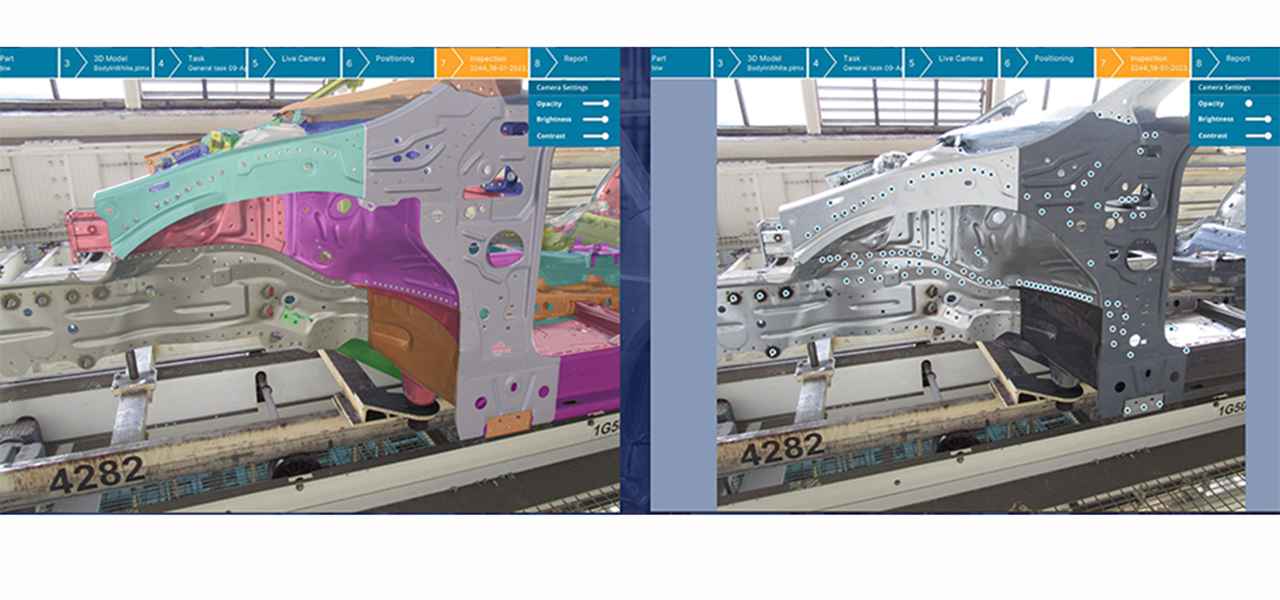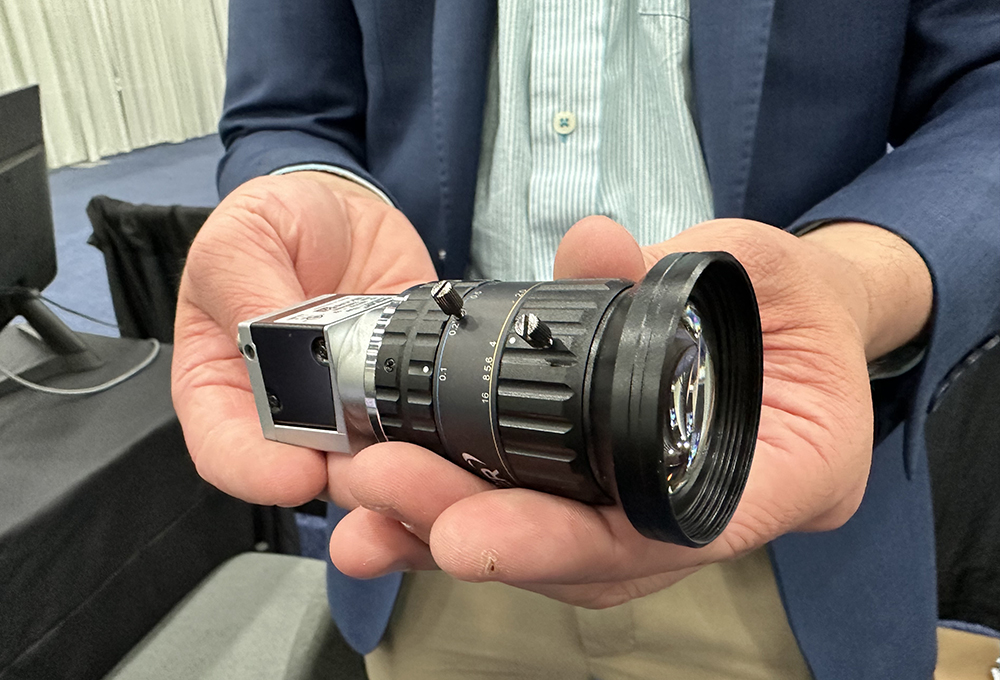 SkillReal演示用的一张幻灯片显示了数字孪生体(左侧)以及公司的检测照片。(SkillReal)
SkillReal演示用的一张幻灯片显示了数字孪生体(左侧)以及公司的检测照片。(SkillReal) Peter Grabowski展示了技术的一部分,该技术与SkillReal的算法相结合,可以提高零部件检测的速度和准确性。(SAE | Chris Clonts)
Peter Grabowski展示了技术的一部分,该技术与SkillReal的算法相结合,可以提高零部件检测的速度和准确性。(SAE | Chris Clonts) 该系统只需最小的占地面积和一名操作员,八小时的轮班即可完成培训。(SkillReal)
该系统只需最小的占地面积和一名操作员,八小时的轮班即可完成培训。(SkillReal) 在进行亚毫米级比较之前,系统会生成一张标准的二维照片。(SAE | Chris Clonts)
在进行亚毫米级比较之前,系统会生成一张标准的二维照片。(SAE | Chris Clonts)
SkillReal使用市售小型摄像头和自研算法,大大加快了人工检测或设备检测的速度。
一家公司称,他们通过结合复杂AI算法,结合市售摄像头,开发出了一款数字孪生对准系统。该系统有可能改变汽车行业,为生产线的缺陷检测过程节省高达 200 亿美元。
通常情况下,焊点、螺栓孔等部位的检测主要通过以下三种方式进行:
- 缓慢且错误率高的人工检测;
- 速度更慢的坐标测量机检测,检测150个焊点可能需要数小时;
- 激光等技术,非常昂贵,但不能保证完美无缺
以色列公司SkillReal刚刚在大众沃尔夫斯堡工厂完成技术验证,最近正式公开亮相。该公司表示,只需使用一个售价约1000美元的摄像头和一台游戏笔记本电脑,其软件就可以在短短几秒钟内将零件照片与数字孪生体进行比较,并指出缺陷。
这与一些OEM和供应商的传统做法截然不同,他们通常交给检测员一支记号笔和一份显示焊点位置等特征的 PDF文件,然后由检测员目测比较零件与文件,并标记零件缺陷。
SkillReal的一位顾问表示,对供应商和制造商而言,实现效率和成本控制的关键在于及时发现问题,避免拖到下一零件生产或子装配完成后才发现。
SkillReal的创始人兼CEO是 Shai Newman,他在创立SkillReal之前,曾创立了Compedia,一家帮助出版商将其内容转化为虚拟3D教育环境的公司。西门子曾与Compedia开展合作,设计一种能为其生产线检测员的AR眼镜提供支持的系统。2D摄像头检测技术的想法正是诞生于这次合作。
他同时表示,相信SkillReal的先发优势和一系列专利,可以保护其免受潜在竞争对手的威胁。
A company says that its digital twin alignment system, incorporating a sophisticated AI algorithm and an off-the-shelf camera, has the potential to revolutionize the auto industry, potentially saving it up to a staggering $20 billion in the effort to detect defects on the manufacturing line.
Generally, such inspections of spot welds, bolt holes and the like are handled one of three ways:
- Slow manual inspections that can have high error rates.
- Even slower inspection with coordinate-measuring machines (CMMs) that can take hours to inspect 150 spot welds.
- Tremendously expensive technology, such as lasers, that still aren’t perfect.
SkillReal, an Israeli company that just exited stealth mode after proving its technology at Volkswagen’s Wolfsburg plant, says that using a roughly $1,000 camera and a gaming laptop, its software can compare a photo of a part with a digital twin, highlight problems and be completed in mere seconds.
That’s in contrast with what some OEMs and suppliers do, which is essentially hand an inspector a Sharpie and a PDF showing weld locations and other features. The inspector then visually compares them and marks the part for deficiencies.
Pete Grabowski, SkillReal’s chief operating officer at its North American headquarters in Livonia, Michigan, said the costs of these inspections can really add up because of OEM demands involved in safe launches, in which suppliers are made to pay up to $50,000 a month to third-party companies to ensure parts meet OEM and any regulatory standards. That adds up quickly when a supplier has dozens or hundreds of parts going to multiple vehicle programs.
He said that what sets SkillReal’s system apart is not just detecting features represented in a CAD that have an XYZ coordinate, but how accurate the system is. “We can pinpoint the exact location of those features with submillimeter accuracy. And we do that in seconds.” The system is forgiving, too, able to account for positional variations of the photographed test object. One test of the system that Grabowski called “our John Henry versus the machine” was conducted at a Detroit area stamping and assembly plant. The test pitted SkillReal against the plant’s best marker auditor in a daunting challenge: evaluating welds and other items on the entire underbody of a vehicle involving multiple photos. The plant’s operator finished in 90 minutes. “We were done in less than 10,” Grabowski said.
At the VW plant in Wolfsburg, the results were even more dramatic. Grabowski said VW had two operators working entire eight-hour shifts checking spot welds, while SkillReal’s software covered the same ground in 15 seconds. “They put us through the wringer for two years,” he said. “We want to make sure that these measurements are really sub-millimeter, that you’re really right in saying where they are. So they take parts, measure it with their system, our system, then they put it on a CMM. We got it commercially viable and then launched in the States through our group NorthStar Vision, and now we're adding more features.”
The key to efficiency and cost control for the suppliers and manufacturers, one Skillreal adviser said, is to detect the problem before the next part is built or sub-assembly completed.
The SkillReal software can support up to eight cameras from the same PC running an NVIDIA graphics processing unit. Workers can be trained to use the system in a single eight-hour shift, Grabowski said.
SkillReal’s founder and CEO is Shai Newman. Before Skillreal, Newman founded Compedia, a company that helps publishers transform their content into virtual 3D educational environments. The idea for the 2D-camera inspection technology was born when Siemens approached Compedia in its own search for a system that it hoped would power some kind of augmented reality glasses for the manual line inspectors.
Asked to detail the inner workings of the math, Grabowski said the algorithm does “billions of hardcore computer-vision calculations” that actually break the 2D image up pixel by pixel. “It does the same thing with a 3D model for that perfect overlay,” he said. “And then we layer the AI on top so we can know where to look.” In a nifty compute-saving trick, the system only scans where the components are supposed to be. In other words, there’s no need to waste processor power analyzing locations that don’t include features to inspect.
Grabowski said the company does see more future uses of the technology. “The automotive body in white is our bread and butter for the time being,” he said. “But we see expansion into final assembly of automotive interior trim panels and more. There are so many different avenues that we can use this in automotive alone. No one's doing this type of ultra-fast, sub-millimeter accurate dimensional check.”
He said the company believes its first-mover advantage and series of patents protect it against potential competitors.
等级
打分
- 2分
- 4分
- 6分
- 8分
- 10分
平均分
